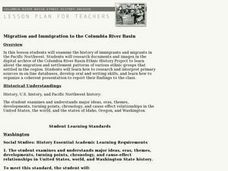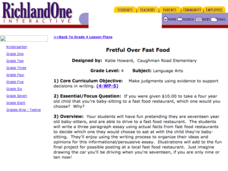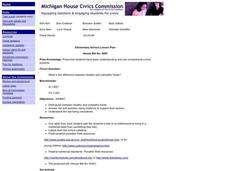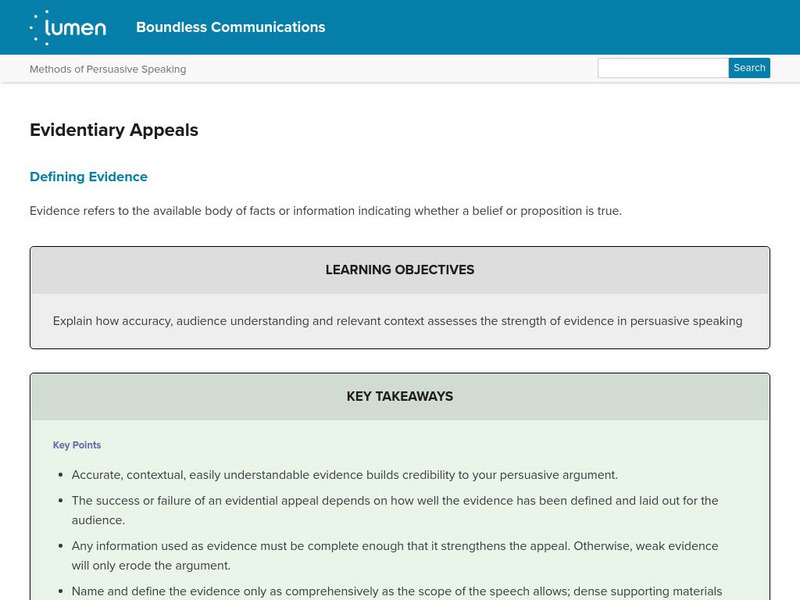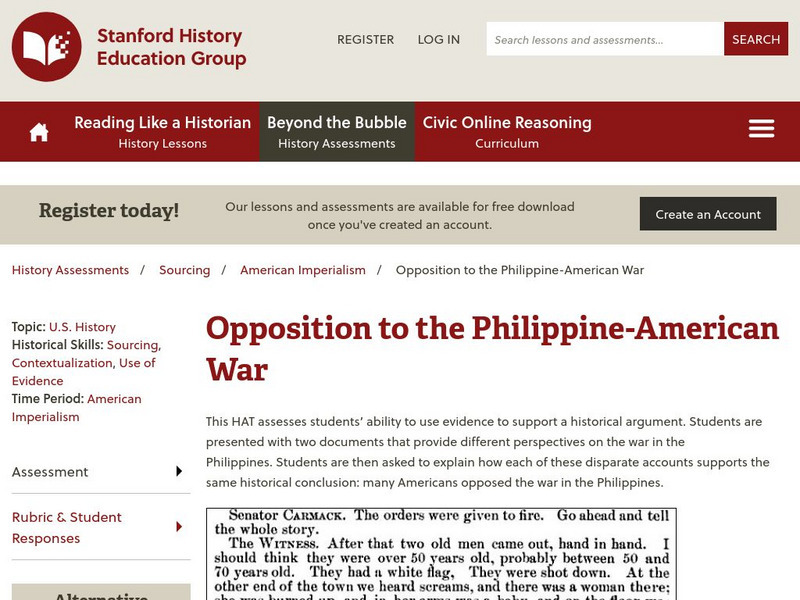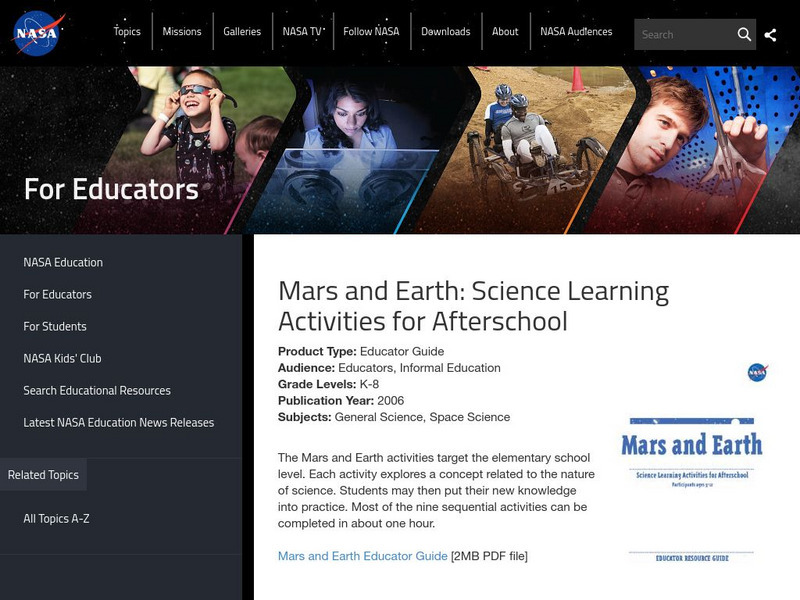Evidence Teacher Resources
Find Evidence lesson plans and worksheets
Showing 329 resources
Curated OER
Who Wants to be a Cellular Biologist?
Eighth graders review concepts in cellular biology. In this biology lesson, 8th graders play an interactive game based on the idea of winning money. They discuss misconceptions about the topic.
Curated OER
Immigration and Settlement of Ethnic Groups in the Pacific Northwest
Students examine ethnic history of the Pacific Northwest in the period 1850-1950. They research documents and images in digital archives to explore immigration of various ethnic groups that settled in the region during this period.
Curated OER
Social Studies: Migration and Immigration to the Columbia River Basin
Students examine the history of immigration in the Pacific Northwest. They make oral and written presentation about the historic effects of immigration in the Northwest.
Curated OER
Scientific Investigation- Magnets
Pupils conduct a scientific investigation to determine if a magnet attracts paper clips through different materials. Students write out their procedures, collect data and present it in a table or chart, and analyze their results.
Curated OER
Radish Seed Garden
Fifth graders explore the effects of overpopulation in an ecosystem while applying the scientific method. They discuss overpopulation and its meaning. Students as an organism competes for space in an overpopulated area. They plant...
Curated OER
Fretful Over Fast Food
Fifth graders research fast food options and write an essay on the topic. In this fast food lesson, 5th graders pretend they are a babysitter and research fast food restaurant options to eat at while they are baby-sitting. Students write...
Curated OER
Forests
Fourth graders examine the impact forests have on our lives. They listen to the book "The Giving Tree" by Shel Silverstein, and brainstorm about how forests are important to us. In small groups they create a poster illustrating how the...
Curated OER
House Bill No. 4097
Learners identify healthy and unhealthy foods while considering a bill that would ban certain foods in schools. Through survey and discussion, they discuss a proposed legislative bill that would ban certain types of food in schools....
Curated OER
The Empires of Early Africa
Students view the video "Empires of Early Africa." They are asked: Who was Nefertiti? They review the facts about Akhenaten and Nefertiti. Students discuss how archaeologists looked for clues to determine the identity of the mummy...
Curated OER
Ecology: Symbiosis
Eighth graders identify various types of symbiotic relationships. In this ecology lesson, 8th graders predict whether certain organisms can form symbiosis with other organisms. They discuss and defend their reasoning.
Curated OER
Ecology: Adaptations
Eighth graders identify different types of adaptation in organisms. In this biology lesson, 8th graders explain how adaptation help organisms survive. They complete a worksheet at the end of the lesson.
Imagine Learning Classroom
Learn Zillion: Describe a Character Using Evidence From the Character
In this lesson, you will learn to describe a character in a story by drawing on characters' words. [6:50]
Other
Walden University: Using Evidence: Direct Copy and Pasting From Source
Learn some strategies to avoid plagiarism.
Lumen Learning
Lumen: Boundless Communications: Evidentiary Appeals
This lesson focuses on the use of evidentiary appeals in persuasive speeches including definition, evaluating your evidence, and strategies for using evidence effectively. Click on next at the bottom right to continue.
PBS
Pbs Learning Media: The Moon's Changing Appearance in the Sky: Lesson Plan
Observe how the Moon appears to change in the sky over time in this GBH lesson plan. Learners will observe and use evidence from media to describe and record how the Moon appears to change. The media in this lesson plan includes a...
Constitutional Rights Foundation
Constitutional Rights Foundation: The Chinese Civil War: Why Did the Communists Win? [Pdf]
Article looks at war and military by examining the Chinese Civil War between the Nationalists and Communists. Includes questions for discussion and writing and small group activity in which students use evidence to support the main...
Other
Pde Sas: Relationships Among Organisms
In this lesson, students compare various types of relationships among organisms (i.e., biotic interactions). Students will: explain the roles of producers and consumers, and predators and prey in an ecosystem. Explain the levels of order...
Stanford University
Sheg: Document Based History: Reading Like a Historian: Pocahontas
[Free Registration/Login Required] Students use primary source documents to investigate central historical questions. In this investigation, students use evidence to explore whether Pocahontas actually saved John Smith's life and...
Stanford University
Beyond the Bubble: Civil Rights Movement in Context
[Free Registration/Login Required] The two letters presented here are from the archives of the National Association for the Advancement of Colored People (NAACP) and were written over twenty years apart. Students must read the letters...
Stanford University
Beyond the Bubble: Opposition to the Philippine American War
[Free Registration/Login Required] Assesses students' ability to use evidence to support a historical argument. Students are presented with two documents that provide different perspectives on the war in the Philippines. Students are...
Stanford University
Sheg: Document Based History: Reading Like a Historian: Maine Explosion
[Free Registration/Login Required] Students solve a problem surrounding a historical question by reading primary source documents. When the USS Maine exploded in Havana Harbor, triggering the Spanish-American War, the New York Times and...
NASA
Nasa: Mars and Earth: Science Learning Activities for Afterschool
This set of activities teaches students about the big picture of science using Mars as an example: how to collect data, use evidence, and look at models.
NASA
Nasa: Mars and Earth: Science Learning Activities for Afterschool
This set of activities teaches students about the big picture of science using Mars as an example: how to collect data, use evidence, and look at models.
Concord Consortium
Concord Consortium: Exploring Earth's Seismicity
This sequence is an introduction to plate tectonics using evidence from topographical maps, earthquake location and depth, and volcano location using the Seismic Explorer model to investigate patterns of earthquake data and to infer the...




